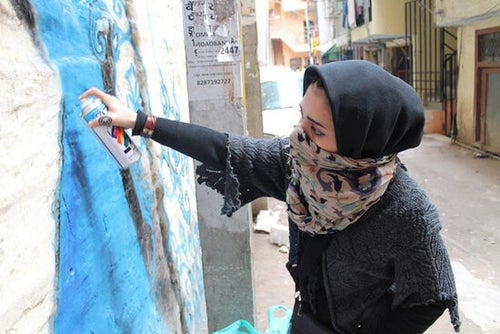Now, to anyone thinking that graffiti is just a public nuisance produced by overgrown teenagers with underdeveloped egos: you couldn't be more wrong - at least in this case.
I met with Shamsia Hassani: a young woman and the first street artist ever to emerge from the exhausted streets of Kabul, Afghanistan.
Only 25 years old and teaches drawing at the Faculty of Fine Arts at Kabul University, her story just might challenge your views on graffiti - and on Afghan women.


Fear
"For two years I was the only graffiti artist in Afghanistan," Shamsia says, and considering the massive perils, one has to undergo to paint graffiti in the streets of Kabul, it is no wonder that people have been a bit cautious picking up the trend.
Shamsia has faced various kinds of threats and harassment when painting:
"It is very dangerous for a girl to paint in the streets in Kabul," she says, "sometimes people come and harass me; they don't think it is allowed in Islam for a woman to stand in the street and do graffiti."
And vigilante citizens are not the only threats facing an Afghan graffiti artist, suicide bombings are still a very real danger in Kabul, Shamsia tells me.
"That's why I paint very fast, when I paint in the streets," she says and squeezes one hand with the other.
Why?
But, rather than the perils she has to undergo in order to paint, it is the question 'why?' that makes Shamsia's story interesting: why would a young Muslim woman, risk her life to go and paint graffiti in Afghanistan?
Then again, why would anyone risk anything to paint graffiti?
Thrill, passion, self-exposure are common conceptions of motivation for graffiti artists - but not really satisfying ones. Shamsia knows why she paints.
Cover
Fear of bombings might still be part of the everyday in Kabul, but so are a lot of other things, like the treatment and development of a shattered community, the fight for women's rights, the struggle for freedom of speech, not to mention the toils of altering Afghanistan's image in the eyes of the outside world. "I just want some happiness," Shamsia says and looks down at her paint stained fingers.
That's why she paints.
Shamsia's motifs are both letter- and character based, and they address topics of freedom of speech and women's rights.
She paints a guitar playing the alphabet, so you can sing out any words you want. She paints a fish with a big, black bubble of suppressed breath in its belly because "things grow dark as they age."
And she paints a woman in a burka who is "strong, happy and with movement" illustrating her point that the prison of the Afghan woman is not the burka, but her lack of rights - and that problem, Shamsia says, is not solved by simply removing the burka.
Paradise?
It is difficult not to sympathize with Shamsia's actions, and hearing her reasons for painting the term vandalism seems wildly out of place:
"I want to cover the memories of war from peoples mind," she says and adds: "If I do graffiti on some destroyed wall it is like I cover all the bad memories, then, when people see that wall, they cannot remember that bad memories are in it."
Shamsia expresses a beautiful naïveté, an optimistic spirit essential to any fight for freedom and to the rebuilding of a recent warzone - but what about our western graffiti artists, what do their paintings mean; what do they fight for?
Maybe we believe that our struggles are over, that there is nothing left to fight for, and that that is actually a good thing?
Shamsia can paint for peace, she can paint for women's rights or the freedom of speech, but what is the goal of the western graffiti artist, the one sprouted from a seemingly post-ideological society - what are they expressing?
Shamsia vandalizes buildings scarred by war; western graffiti artists vandalize buildings scarred by nothing.
Maybe there's a message in that?